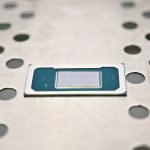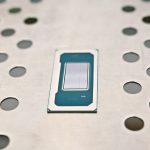KitGuru spent six days with Intel in Phoenix, Arizona learning about their ground-breaking 18A fabrication process which will be used in Panther Lake laptops. It is no secret that Intel has had a rotten few years and ended up having their processors made by arch-rival TSMC in Taiwan. 18A is of critical importance to Intel and could literally define the future of the company. On the other hand, if things go wrong, it could potentially be the end of the road for this American giant.
00:00 Leo’s visit to Intel Fab
02:05 Panther Lake and Process Technology
02:34 Transistor Innovations / Lithography
03:25 Alas an Intel Slide
03:44 AI, Here we go again
04:02 Paradigm Shift
04:29 Disaggregation Journey
04:50 Intel 18A Process / PowerVia
05:46 Backside Power Solution
06:01 The Result
06:14 U.S. Fabs / Foundry Node
06:56 Advanced Packaging Portfolio / Foveros S
07:15 Panther Lake – a closer look
09:59 Details on the 3 versions
11:58 Architectural Scalability
12:29 Core IP / Cougar Cove / Darkmont
13:02 Single and Multi Thread Performance
13:35 Xe Graphics
15:30 Gaming with low power / XeSS / Precompiling shaders
17:33 Intelligent Bias Control
18:23 ‘Built For Scale’
18:37 Leo’s Closing Thoughts
Intel first announced its plans for RibbonFET and PowerVia all the way back in 2021. At the time, these technologies were to debut on the Intel 20A process node, but plans shifted, with Intel skipping ahead to its 18A process instead. RibbonFET is Intel's new transistor architecture, enabling faster transistor switching speeds, greater efficiency gains and more. On top of that, PowerVia is now being used in Intel chips, providing backside power delivery to optimise signal routing.
For packaging, Intel is using its Foveros-S technology, which is a proven quantity, having been used in large-scale manufacturing since 2019.
Panther Lake CPUs for laptops will be the first on the market built using Intel 18A. Intel claims that Panther Lake will provide up to a 50% gain in CPU and GPU performance, but that may depend on the version you buy. There are three versions of Panther Lake, an 8-core version, a 16-core version and another 16-core version but with extra Xe graphics cores for more of a boost. In all cases, the majority of compute engines are now housed on the compute tile, all I/O is moved to the PCD tile, the GPU tile is another separate component, giving Intel extra scalability when putting these CPUs together.
The Compute tile in Panther Lake is produced on the Intel 18A process, while the Xe 3 GPU tile is built using the Intel 3 process. The platform controller tile is outsourced. The exception here is the 16-core chip with the upgraded 12-core GPU, where the Compute tile remains on Intel 18A, but both the platform controller tile and the GPU tile are using an external process.
Memory support on Panther Lake will be massively improved compared to Lunar Lake. With Lunar Lake, the memory was on-package, giving laptop buyers no wiggle room for future upgrades. This has been fixed with Panther Lake, giving laptop makers a choice between LPDDR5x memory, or modular DDR5 memory sticks that the end user can freely replace or swap out. Top-end Panther Lake CPUs will support up to 96GB of LPDDR5 memory with speeds up to 9600MT/s, or up to 128GB of DDR5 memory with speeds up to 7200MT/s.
In a base Panther Lake CPU, you can expect an 8-core CPU with an even split between P-Cores and E-Cores, as well as a GPU tile sporting four Xe3 cores and four ray-tracing units. Other goodies include Intel Wi-Fi 7 and Intel Bluetooth Core 6.0, 12 total PCIe lanes, up to 4x Thunderbolt 4 and 8MB of memory-side cache. Intel's NPU 5 is included to power AI applications. For memory support, we are looking at up to 6800MT/s speeds for LPDDR5x and up to 6400MT/s for DDR5.
In the 16-core Panther Lake variant, you'll find the CPU split between four P-Cores, eight E-Cores and another four LP E-Cores. Memory support here is upgraded to 8533MT/s for LPDDR5x and 7200MT/s for DDR5. The GPU tile remains the same, but the I/O is upgraded with 20 PCIe lanes, split between 12 Gen5 lanes and 8 Gen4 lanes.
Finally, at the top of the stack is the Panther Lake 16-core 12Xe, which as the name implies, has a larger emphasis placed on the integrated graphics component. The GPU tile is upgraded with 12 Xe3 cores and 12 ray-tracing units. Other specifications remain largely the same, aside from four fewer PCIe lanes across both Gen5 and Gen4. Memory support is also updated for up to 9600MT/s LPDDR5x memory.
While not mentioned in the slides, Intel confirmed that all three versions of Panther Lake are pin-compatible with one another, which should help reduce development costs for laptop makers, as they'll only need to worry about one board design for CPU-only laptops, and another one for laptops with a discrete GPU.
Intel has updated its core architecture technology for these CPUs as well. The E-Cores are based on Darkmont and the P-Cores are based on Cougar Cove. Intel claims that during single-threaded tasks, its new Panther Lake CPUs can reduce power usage by as much as 40% while maintaining similar performance to its former Lunar Lake and Arrow Lake H laptop chips. Alternatively, it can offer more than 10% more performance while operating at similar power. For multi-threaded tasks, the power saving is said to be around 30% while keeping performance in line with Lunar Lake and Arrow Lake H.
In the slides above, you can see Intel's comparison between Xe 2 and Xe 3. Interestingly, the Xe 3 GPUs found in Panther Lake are still based on the Battlemage architecture, so we'll have to wait a bit longer to see Intel's third-generation graphics architecture, named ‘Celestial'.
With Xe 3, Intel has spent a great deal of time optimising its graphics pipeline, reducing latency within the chip to push graphics processes out faster. Intel has also spent more time on its Intelligent Bias Control system. Panther Lake gets V3, which optimises processes further to enable smooth CPU and GPU power delivery, thus improving efficiency.
On top of that, Intel is now introducing XeSS-MFG, its own multi frame generation technology to bring further performance gains to low-power gaming systems. This new system will allow for up to 4x frame generation, matching Nvidia's DLSS 4 implementation. In a future Intel Graphics Software update, users will be able to force-enable XeSS Frame Generation with a driver-level override. It is unclear if this feature will be limited to Panther Lake, or if it will be enabled on Intel's Battlemage discrete graphics cards as well.
The first Panther Lake laptops are expected to be announced at CES 2026, which is just a few months away.
KitGuru says: We shall have to wait until early 2026 for Panther Lake to arrive and are keen as mustard to crack on with a review.
 KitGuru KitGuru.net – Tech News | Hardware News | Hardware Reviews | IOS | Mobile | Gaming | Graphics Cards
KitGuru KitGuru.net – Tech News | Hardware News | Hardware Reviews | IOS | Mobile | Gaming | Graphics Cards




















